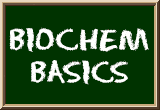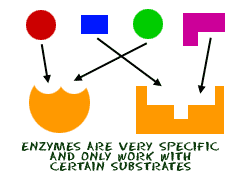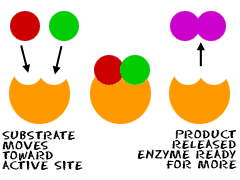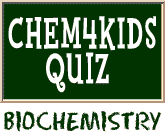
Enzymes Make the World Go 'Round
 We have a whole section where we tell you about reactions and the molecules that change in those reactions. Chemical bonds are being created and destroyed over a series of many intermediate reactions. Those changes rarely happen on their own when you look at biological systems.
We have a whole section where we tell you about reactions and the molecules that change in those reactions. Chemical bonds are being created and destroyed over a series of many intermediate reactions. Those changes rarely happen on their own when you look at biological systems.
Will a blob of protein in a Petri dish simply break down into amino acids? No. To break a protein down into its amino acids you will need enzymes. Enzymes are biological molecules (proteins) that act as catalysts and help complex reactions occur everywhere in life. Let’s say you ate a piece of meat. Proteases would go to work and help break down the peptide bonds between the amino acids.
Will all enzymes break down all substances? No. Enzymes are very specific catalysts and usually work to complete one task. An enzyme that helps digest proteins will not be useful to break down carbohydrates. Also, you will not find all enzymes everywhere in the body. That would be inefficient. There are unique enzymes in neural cells, intestinal cells, and your saliva.
Assembly Line Robots
You all know about cars and the assembly lines where they are made. There are giant robots helping people do specific tasks. Some lift the whole car, some lift doors, and some put bolts on the frames. Enzymes are like those giant robots. They grab one or two pieces, do something to them, and then release them. Once their job is done, they move to the next piece and do the same thing again. They are little protein robots inside your cells. The robot that was designed to move a car door can't put brakes on the car. The specialized robot arms just can't do the job. Enzymes are the same. They can only work with specific molecules and only do specific tasks. Because they are so specific, their structure is very important. If only one amino acid of the enzyme is messed up, the enzyme might not work. It would be as if someone unplugged one of the cords in a robot.
The robot that was designed to move a car door can't put brakes on the car. The specialized robot arms just can't do the job. Enzymes are the same. They can only work with specific molecules and only do specific tasks. Because they are so specific, their structure is very important. If only one amino acid of the enzyme is messed up, the enzyme might not work. It would be as if someone unplugged one of the cords in a robot.
For example, some herbicides are used to block plant enzyme activity. A tiny herbicide molecule can attach to the active site of an enzyme and stop it from working. Plants have adapted by changing one or two amino acids in their enzymes. They adjust their structure, are able to continue working, and the herbicide can no longer limit the enzyme.
Four Steps of Enzyme Action
1. The enzyme and the substrate are in the same area. Some situations have more than one substrate molecule that the enzyme will change.2. The enzyme grabs on to the substrate at a special area called the active site. The combination is called the enzyme/substrate complex. Enzymes are very, very specific and don't just grab on to any molecule. The active site is a specially shaped area of the enzyme that fits around the substrate. The active site is like the grasping claw of the robot on the assembly line. It can only pick up one or two parts.
3. A process called catalysis happens. Catalysis is when the substrate is changed. It could be broken down or combined with another molecule to make something new. It will break or build chemical bonds. When done, you will have the enzyme/products complex.
4. The enzyme releases the product. When the enzyme lets go, it returns to its original shape. It is then ready to work on another molecule of substrate.
► NEXT PAGE ON BIOCHEMISTRY
► NEXT STOP ON SITE TOUR
► BIOCHEMISTRY QUIZ
► RETURN TO TOP OF PAGE
► Or search the sites...
► NEXT STOP ON SITE TOUR
► BIOCHEMISTRY QUIZ
► RETURN TO TOP OF PAGE
► Or search the sites...
Related Video...
Enzyme Molecules as Nanomotors (American Chemical Soc.)
Encyclopædia Britannica: Enzymes
Wikipedia: Enzymes
Wikipedia: Enzyme Catalysis
Encyclopedia.com: Enzymes



